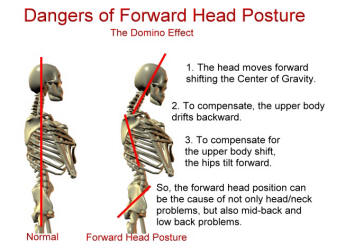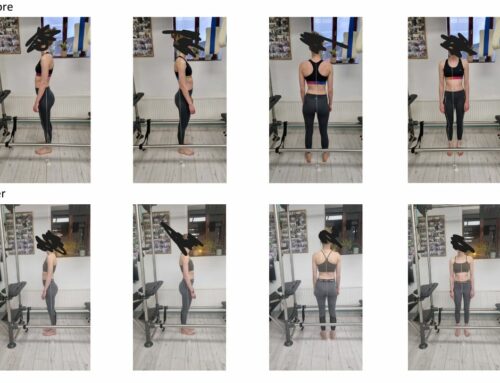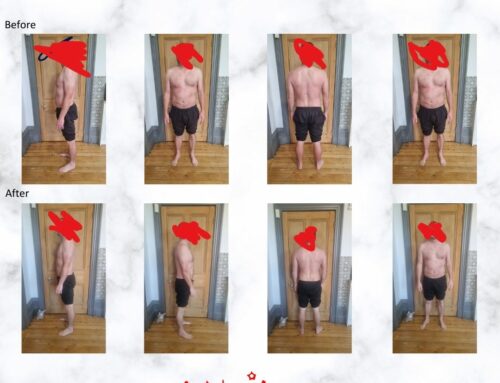Gravity pulls us towards the earth at 9.8 meters per second squared (m/s2). Coupled with habitual patterns learnt from parents, plus lifestyle habits and even stress, all these factors can contribute to a forward head protrusion.
In many clients that I have seen including myself, a forward head starts when the cervical ligaments, the bands of connective tissue that hold the cervical vertebrae in place weaken, and the natural cervical lordotic curve of the neck is lost and the plumb line (and thus weight) of the head falls in front of the cervical curve. The result of a forward head is shown in the survival chain. They all go hand in hand with one another – back pain, neck pain, restriction of your breathing, eyesight, dental issues (bite), osteoporotic fractures, and associations with asthma, headaches, and it can even contribute to carpal tunnel syndrome.

There is also a mental, emotional, and spiritual component that contributes to a forward head. What is in the mind shows up in the body. We can have many areas or joints that seem to get stuck in the body. Emotional energy and feelings such as anger, frustration, judgement, jealousy, despair, and sadness should always be kept moving through expression.
Peter Levine’s work on trauma talks about how animals behave after they have been traumatised – they roll and shake as it helps to reset the central nervous rhythm.
When we get down onto the ground, we learn to connect to ourselves and learn and listen to the body. The floor builds more awareness to our emotions. Many eastern cultures sit on the floor to work and eat. This helps keeps us from stagnation and the oscillators of the body can do their job properly. Being low to the floor also keeps us grounded and connected.
The body has its’ own innate wisdom, the whole concept of life is to get out of our heads and into our body. We need to feel as the shaman and medicine men did long ago. Movement is just one part of the puzzle for healing. As we all know, all pain is multi-factorial.
Rolling and wiggling movements are part of infant development philosophies. Some of these moves show up in the Pilates mat work system. The exercise ‘Rolling like a ball’ is not a specific stretch or mobilization. Instead, it brings your mind down and into your body. When we move in this way, your body guides you with intuition, instinct and feeling. Little technical knowledge is needed in what I am going to do with you next. Click here
Not everyone enjoys these moves and if you know this is going to aggravate your back, don’t do it!
But those who do feel comfortable with ‘Rolling like a ball,” try taking rolling from a linear plane to right and left; even try rolling in a circle. Try inhaling on the roll back and then repeat with exhaling on the roll back. What did you feel? Every time we inhale, we activate all of the muscles that pull us OUT of the foetal position. Every time we exhale, we activate everything that pulls us INTO the foetal position. Let your fascial body relax and lengthen, roll with the impulse of the body.
Holding a foetal position can help to release the junction box of the spine called the thoracolumbar fascia. You can further advance your stretch by taking a deep diaphragmatic breath. This is because the body expands from the inside. As you find the playfulness in your foetal position, you see where you want to go.
Is your forward head and eyesight connected?
So, going back to the subject line, you can see why sight and glasses definately can be one of links to movement, back pain and posture.
I measure the forward head posture using a CHEK Forward Head Calliper. Click here to view the assessment!
This measurement is to assess head deviation from a neutral position. Faulty posture of the head is a contributing factor to the onset and continuation of many postural imbalances. The force of gravity causes an increase in neck tension, sight problems, and deformations with teeth, TMJ disorders, headaches, and premature degeneration at the base of the spine. Poor posture is a faulty relationship which induces strain and is less efficient in balancing the body over its base of support. When the head is about 6cm in forward head posture, which is common, the weight of the head on the upper spine changes from 10 lbs to 30 lbs! This assessment is one of over 250 assessments that I do in a CHEK four-hour consult.
Think you need help?
Dm me your email and phone number for a consultation
Bibliography
Paul Chek
Feldenkrais






